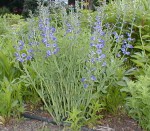
Native to meadows, woodland borders and streamsides of eastern and central US, this herbaceous perennial is a member of the bean family, Fabaceae, that also includes lupine, mimosa, and black locust. The plant quickly grows 3-4′ tall and develops into a substantial, vase shaped bush with gray stems carrying trifoliate, gray-green with leaflets up to 2′ long. In spring, racemes up to 16” long appear bearing soft blue flowers similar in shape to those of sweet pea. Black pods 2”-2 1/2” long follow and remain until fall when the stems and leaves die down. They add to the over all attractiveness of the plant and are also desirable additions to flower arrangements. Although Baptisia is a large plant, it is not heavy or coarse and therefore looks well at the front or back of the border where it can add variety in size as well as in texture and color. Baptisia is very long lived and resents being moved so should be placed where it can remain and be enjoyed.Thegenusname,Baptisia,is from the Greek word βάπτω (bapto), meaning to dip or dye, and refers to the use of plants in the genus as an indigo dye. The specific epithet, australis, comes from the Latin word auster, meaning south, and refers to the geographic range of the plant.
Type: Herbaceous perennial.
Bloom: 1” blue sweet pea like blooms in spring.
Size: 3’-4’ H 3’-4’ W; vase-shaped.
Light: Full sun for best growth; in shade it will need staking.
Soil: Prefers moist, deep, humusy, acid soil but tolerates poor soil.
Fertilizer: Apply a high phosphorus (middle number) water soluble fertilizer immediately after flowering.
Hardiness: Zones 3-9.
Care: Water during droughts; remove the spikes after flowering to maintain vigor; trim back the foliage in the fall when it looks bedraggled.
Pests and Diseases: None of importance.
Propagation: Can be grown from seed collected from garden plants but may take 2 years to bloom and 3 years to gain full size. Divisions are possible but very difficult because the root is a taproot. Expect some failure if you attempt division.
Companion plants: Carolina lupine(yellow); cranesbills, miniature red roses, asters or chrysanthemums at its feet to hide its “ankles”.
Outstanding Selections:
‘Carolina Moonlight’ (soft yellow flowers)
l‘Screeming Yellow’ (bright yellow flowers)
var. minor (dwarf)
Photo Credit Wikipedia
